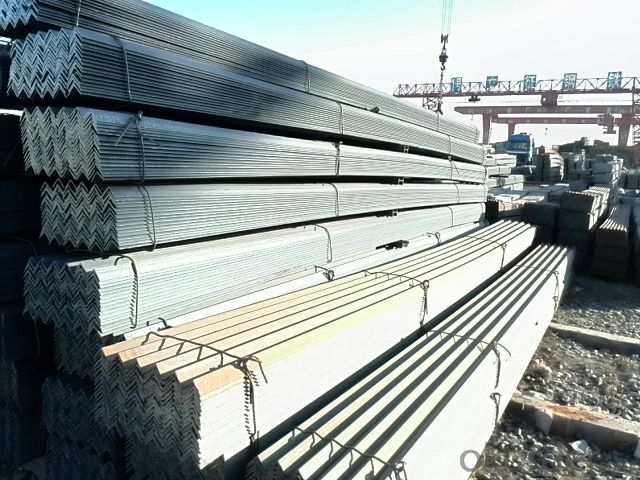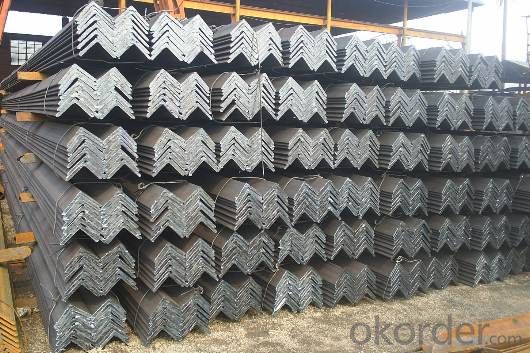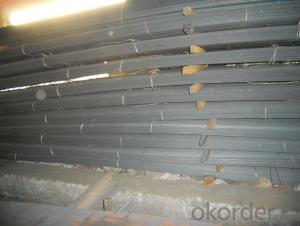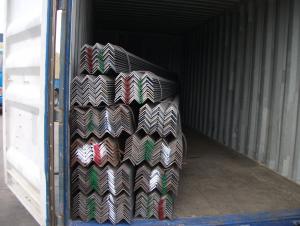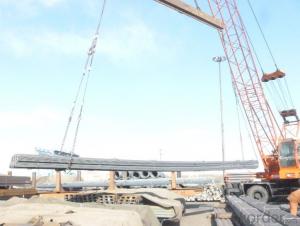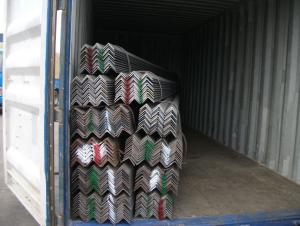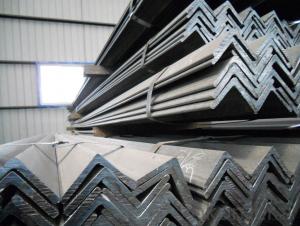Hot Rolled Equal Angle steel with high quality
- Loading Port:
- Tianjin
- Payment Terms:
- TT OR LC
- Min Order Qty:
- 25 m.t
- Supply Capability:
- 10000 m.t/month
OKorder Service Pledge
OKorder Financial Service
You Might Also Like
Specification
Okorder.com is a professional materials & equipment supplier & manufacturer, offers integrated one-stop services including real-time quoting and online cargo tracking. We are funded by CNBM Group, a Fortune 500 enterprise and the largest materials & equipment firm in China.
Product Applications:
According to the needs of different structures, Angle can compose to different force support component, and also can be the connections between components. It is widely used in various building structures and engineering structures such as roof beams, bridges, transmission towers, hoisting machinery and transport machinery, ships, industrial furnaces, reaction tower, container frame and warehouse etc.
Product Advantages:
OKorder's Steel Angles are durable, strong, and resist corrosion.
Main Product Features:
· Premium quality
· Prompt delivery & seaworthy packing (30-45 days after receiving deposit)
· Corrosion resistance
· Can be recycled and reused
· Mill test certification
· Professional Service
· Competitive pricing
Product Specifications:
1. Invoicing on theoretical weight or actual weight as customer request
2. Length: 6m, 9m, 12m as following table
3. Sizes
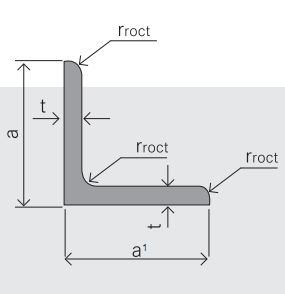
Sizes: 25mm-250mm | ||
a*t | ||
25*2.5-4.0 | 70*6.0-9.0 | 130*9.0-15 |
30*2.5-6.6 | 75*6.0-9.0 | 140*10-14 |
36*3.0-5.0 | 80*5.0-10 | 150*10-20 |
38*2.3-6.0 | 90*7.0-10 | 160*10-16 |
40*3.0-5.0 | 100*6.0-12 | 175*12-15 |
45*4.0-6.0 | 110*8.0-10 | 180*12-18 |
50*4.0-6.0 | 120*6.0-15 | 200*14-25 |
60*4.0-8.0 | 125*8.0-14 | 250*25 |
4.Material details:
Alloy No | Grade | Element (%) | |||||
C | Mn | S | P | Si | |||
Q235 | B | 0.12—0.20 | 0.3—0.7 | ≤0.045 | ≤0.045 | ≤0.3 | |
Alloy No | Grade | Yielding strength point( Mpa) | |||||
Thickness (mm) | |||||||
≤16 | >16--40 | >40--60 | >60--100 | ||||
≥ | |||||||
Q235 | B | 235 | 225 | 215 | 205 | ||
Alloy No | Grade | Tensile strength (Mpa) | Elongation after fracture (%) | ||||
Thickness (mm) | |||||||
≤16 | >16--40 | >40--60 | >60--100 | ||||
≥ | |||||||
Q235 | B | 375--500 | 26 | 25 | 24 | 23 | |
FAQ:
Q1: Why buy Materials & Equipment from OKorder.com?
A1: All products are carefully selected from China's most reliable manufacturing enterprises. Through its ISO certifications, OKorder.com adheres to the highest standards and a commitment to supply chain safety and customer satisfaction. We can guarantee the quality!
Q2: The products are invoicing on theoretical weight or on actual weight?
A2: We can do it in both manners, it’s according to buyer's requirement.
Q3: Can fit in the containers of 20fts for 6M long ?
A3: Yes, we can put them into the containers in the form sideling, in this way we can save the buyer much ocean freight.
Images:
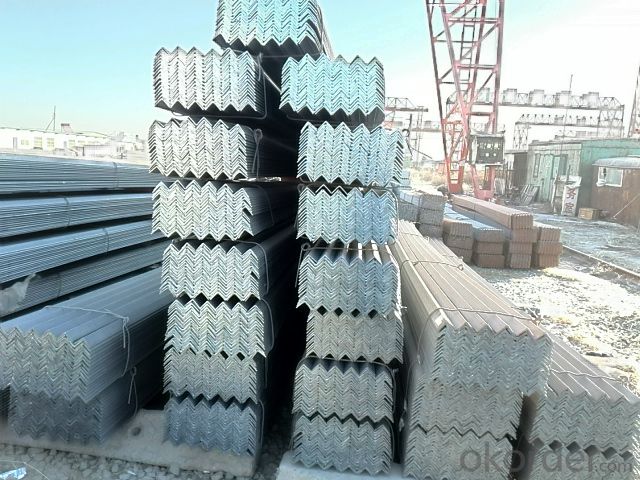
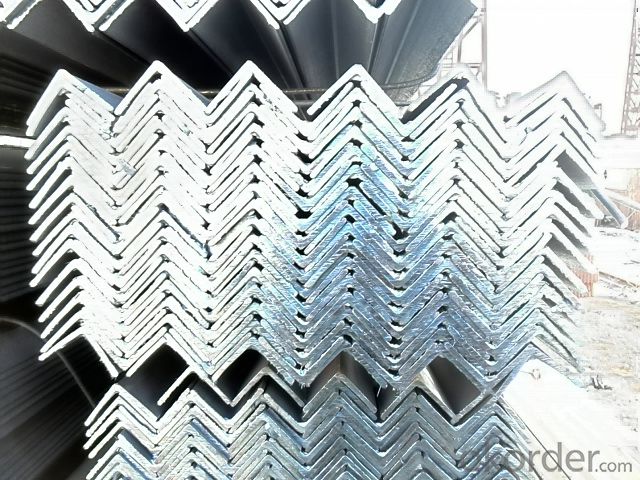
- Q: Can steel angles be used for cable trays?
- Yes, steel angles can be used for cable trays. Steel angles provide strength and support, making them suitable for holding cables and providing a stable structure for cable trays. The rigid and durable nature of steel angles ensures that the cable trays can withstand the weight of the cables and any additional loads. Additionally, steel angles can be easily fabricated and customized to fit specific requirements, making them a versatile choice for cable tray installations.
- Q: Can steel angles be used in the construction of airport terminals?
- Yes, steel angles can be used in the construction of airport terminals. Steel angles are commonly used in structural applications because of their strength and durability. They can be used for framing, support, and reinforcement in various structural elements of airport terminals, such as columns, beams, and trusses.
- Q: What are the common surface treatments for steel angles?
- Different surface treatments are available for steel angles, depending on the desired application and level of corrosion resistance needed. Some commonly used surface treatments are: 1. Hot-dip galvanizing: To achieve excellent corrosion resistance, steel angles are submerged in molten zinc, which creates a protective layer on the surface. This treatment is commonly used for outdoor applications. 2. Powder coating: A dry powder is applied to the steel angles and then heated to form a durable and decorative coating. Powder coating provides good corrosion resistance and can be used indoors or outdoors. 3. Painting: Painting is a versatile and cost-effective option for treating steel angles. First, a rust-inhibiting primer is applied, followed by a suitable topcoat. While paint provides a decorative finish and some corrosion resistance, it may not be as long-lasting as other treatments. 4. Electroplating: This process involves depositing a thin layer of metal, like zinc or chrome, onto the steel angles using an electric current. Electroplating offers both corrosion resistance and aesthetic appeal, making it suitable for various applications. 5. Anodizing: Although primarily used for aluminum, anodizing can also be applied to steel angles. It involves creating an oxide layer on the metal surface, which enhances corrosion resistance and durability. Anodizing can also provide a decorative finish and is commonly used in architectural applications. It's important to consider factors such as the intended use, budget, and environmental conditions when selecting a surface treatment for steel angles. Seeking guidance from professionals or experts in the field can help determine the most suitable treatment for a specific application.
- Q: What does L50*4 angle mean in CAD?
- In L50*4, 50 represents the side length of 50mm, and 4 represents the thickness of 4mm.Figures similar to those in H500*200*6*8 represent the overall dimensions of the material.
- Q: Are steel angles suitable for use in high-rise buildings?
- Yes, steel angles are suitable for use in high-rise buildings. Steel angles are commonly used as structural elements in high-rise buildings due to their excellent strength, durability, and versatility. They are able to withstand heavy loads and provide structural support, making them ideal for use in beams, columns, and bracing systems. Steel angles can be easily fabricated and installed, allowing for efficient construction processes. Additionally, steel angles can be designed in various sizes and shapes to meet specific structural requirements, providing flexibility in design and construction. Overall, steel angles are a reliable and cost-effective choice for high-rise buildings as they offer the necessary strength and stability required for such structures.
- Q: Are steel angles prone to warping or twisting?
- Steel angles exhibit a general resistance to warping or twisting, making them highly suitable for a range of structural and manufacturing applications due to their exceptional strength and stability. The production of steel angles involves a hot-rolling process, where the steel billet is heated to a high temperature and then molded into the desired angle shape. This manufacturing technique guarantees that the angles retain their shape and structural integrity. Nevertheless, it is worth noting that steel angles can potentially warp or twist under extreme heat or stress conditions. This is more likely to occur when the angles are exposed to high temperatures, uneven heating or cooling, excessive loads, or improper installation. In such instances, the angles may suffer a compromise in their integrity, resulting in deformation. To minimize the risk of warping or twisting, it is essential to adhere to proper handling and installation procedures. This includes ensuring an even distribution of loads and avoiding prolonged exposure to excessive heat. Moreover, it is advisable to utilize high-quality steel angles from reputable manufacturers and conduct routine inspections to promptly identify and prevent any potential issues. In conclusion, although steel angles generally exhibit resistance to warping or twisting, it is imperative to consider the specific conditions and factors that may impact their stability. Taking appropriate measures to ensure their long-term structural integrity is vital.
- Q: Can steel angles be used in fencing?
- Indeed, fencing can make use of steel angles. Steel angles find frequent application in fencing scenarios, serving to furnish structural reinforcement and stability. Their utility ranges from functioning as posts to serving as crossbars, contingent upon the particular design of the fencing. Steel angles possess robustness and durability, rendering them well-suited for enduring various elements whilst guaranteeing security. Through facile welding or bolting, steel angles can effortlessly be conjoined to construct a resilient fencing structure. Furthermore, steel angles can be galvanized or coated, augmenting their resistance to rust and corrosion, thereby securing a fencing solution that endures for a prolonged period with minimal maintenance.
- Q: What are the different methods of impact testing for steel angles?
- To assess the toughness and resistance of steel angles, engineers and manufacturers have access to various impact testing methods. These include the Charpy V-notch test, the Izod test, and the drop weight test. The Charpy V-notch test is widely utilized and involves placing a notched specimen of the steel angle in a pendulum hammer. Upon release, the hammer swings down and strikes the specimen. The energy absorbed by the specimen before it fractures determines the material's impact toughness. Similarly, in the Izod test, a notched specimen is clamped vertically, and a pendulum hammer strikes it horizontally. The absorbed energy is then measured to evaluate the specimen's impact resistance. Finally, the drop weight test requires dropping a weight onto a supported specimen from a specific height. The impact energy is calculated based on the weight and drop height. The specimen's deformation and fracture behavior are analyzed to determine its impact toughness. These diverse impact testing methods provide engineers and manufacturers with vital insights into the ability of steel angles to endure sudden impacts or shock loads. By assessing the material's toughness and resistance, these tests aid in designing structures and selecting suitable materials for various applications.
- Q: What is the process of galvanizing steel angles?
- To protect steel angles from corrosion, the galvanizing process encompasses multiple steps. Initially, the angles undergo a thorough cleaning process to eliminate any dirt, oil, or rust on the surface. This is achieved through pickling, wherein the angles are immersed in a solution of acid, usually hydrochloric acid, to eliminate impurities. Subsequently, the cleaned steel angles are rinsed to eliminate any remaining acid and are then dried meticulously. This step is crucial to ensure proper adhesion of the zinc coating. Following the cleaning process, the steel angles are immersed in a bath containing molten zinc. This is known as hot-dip galvanizing, where the angles are completely submerged in the zinc bath. The temperature of the bath typically reaches around 840°F (449°C). While the steel angles are immersed in the zinc bath, a metallurgical reaction occurs between the molten zinc and the steel. Consequently, a layer of zinc-iron alloy is formed on the surface of the angles. This layer offers exceptional resistance against corrosion and acts as a barrier between the steel and the corrosive elements present in the environment. Once the angles have been fully immersed in the zinc bath, they are removed and allowed to cool. The cooling process solidifies the zinc coating and ensures its adherence to the steel angles. Finally, the galvanized steel angles undergo a comprehensive inspection to ensure quality control. This involves examining the thickness, uniformity, and adherence of the coating to the angles. Various tests and measurements are conducted to verify that the galvanized coating meets the required standards and specifications. Overall, the galvanizing process for steel angles involves cleaning, immersion in a molten zinc bath, cooling, and inspection. This process yields a robust and long-lasting protective coating on the steel angles, enhancing their resistance to corrosion and extending their lifespan.
- Q: How do you calculate the moment of inertia of a steel angle?
- To calculate the moment of inertia of a steel angle, you can use the basic formula for moment of inertia, which is I = (1/12) * b * h^3, where I represents the moment of inertia, b is the base width of the angle, and h is the height of the angle.
Send your message to us
Hot Rolled Equal Angle steel with high quality
- Loading Port:
- Tianjin
- Payment Terms:
- TT OR LC
- Min Order Qty:
- 25 m.t
- Supply Capability:
- 10000 m.t/month
OKorder Service Pledge
OKorder Financial Service
Similar products
Hot products
Hot Searches
Related keywords



